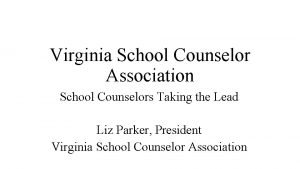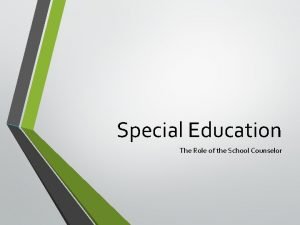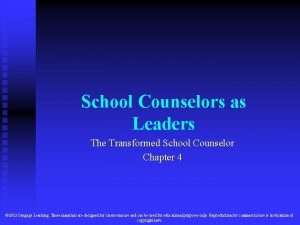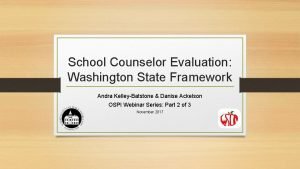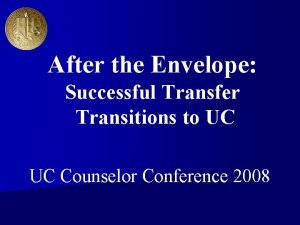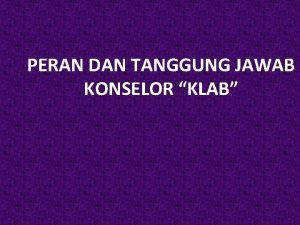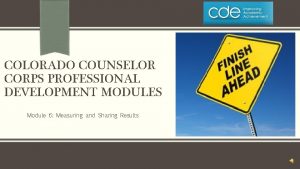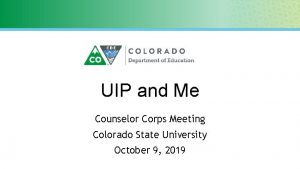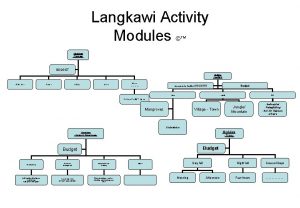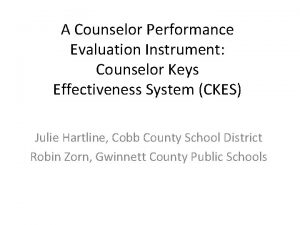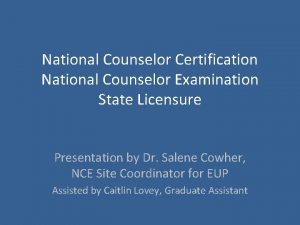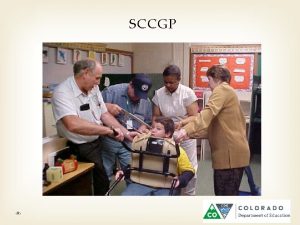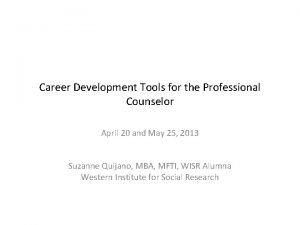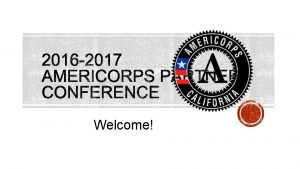COLORADO COUNSELOR CORPS PROFESSIONAL DEVELOPMENT MODULES Module 3




















- Slides: 20

COLORADO COUNSELOR CORPS PROFESSIONAL DEVELOPMENT MODULES Module 3: Conducting Environmental Scans

Module Content q How environmental scans fit into the ASCA National Model and the program planning process q. What is an environmental scan anyway? q The Three Steps of the Environmental Scanning Process § Developing a Methodology § Scanning the Environment § Analyzing the Scan and Drawing Conclusions q Deliverables

ENVIRONMENTAL SCANS WITHIN THE ASCA NATIONAL MODEL

A SNAPSHOT OF PROCESSES Needs Assessment: What problems are identified by key stakeholders? Environmental Scan: What programs and services exist that are intended to meet the needs identified in the needs assessment? Where are the gaps? Comprehensive Strategic Plan: Advisory council and other key stakeholders work with the school counselor to develop strategies to address unmet needs and close service/program gaps.

WHAT IS AN ENVIRONMENTAL SCAN ANYWAY? q “Is more concerned with anticipating the future than describing the present. ” q “Is wider in scope than traditional data collection sources because it is based on the assumption that major impacts on the school system can come from unsuspected sources. ” q “Is focused on the interaction of events and trends. ” q “Is an integral part of the planning process. ” Poole, 1991, pp. 40 & 41

THE THREE STEPS OF CONDUCTING AN ENVIRONMENTAL SCAN 1. Developing a Methodology for the Environmental Scan: Set parameters and plan for the scanning process. 2. Scanning the Environment: Collect data from multiple contexts and ensure inclusion of both internal and external data. 3. Analyzing the Scan and Drawing Conc lusions: Information should ideally come from both perceptionbased measures as well as from archival sources. Project Launch, 2010

STAGE 1: DEVELOPING A METHODOLOGY FOR THE ENVIRONMENTAL SCAN

OVERVIEW OF THE ENVIRONMENTAL SCANNING PROCESS This area of the model is addressed in the current module. Conway, 2009

KEY FACTORS IN YOUR METHODOLOGY § Get administrative and organizational buy-in § Recruit a strong team § Identify and collate important resource tools such as technology and materials for your team § Take time to train your team § Establish benchmarks and timelines § Conduct your activities with the end product in mind

UTILIZE THE SAME GUIDING QUESTIONS AS YOU DETERMINED FOR THE NEEDS ASSESSMENT q ASCA standards and competencies q Program vision and mission statements q Student utilization of services q Stakeholder feedback/requests q “Teacher Lounge Talk” q Observation of the environment q General sense of data trends

STAGE 2: SCANNING THE ENVIRONMENT

ORGANIZATIONAL MODEL OF ENVIRONMENTAL SCAN DATA FOR SCHOOL COUNSELORS

METHODS OF ENVIRONMENTAL SCAN DATA COLLECTION q. Focus Groups q. Interviews q. Questionnaires q. Document Review q. Database Exploration – Including School-wide Data q. State, Regional, and National Websites q. Use a team approach to collect the data § Each team member researches one or more of the factors. § Each team member prepares a list of relevant factual data for the individual factor they are researching. § Team members share their completed list with the entire team.

UTILIZE APPROPRIATE AND RELEVANT ASCA MODEL TOOLS q Individual School Counselor Factors § School Counselor Competency Checklist q. School Counseling Program Factors § School Counseling Program Assessments q Educational Environment Factors § School Data Profile

SOME HELPFUL RESOURCES FOR ACCESSING EXTERNAL DATA Macrosystemic Microsytemic

STEP 3: ANALYZING THE DATA AND DRAWING CONCLUSIONS

PREPARING THE DATA FOR ANALYSIS q. Utilize the Factor Analysis Summary Form 1. List strengths and weaknesses (5 -10) in the appropriate Factors column. 2. Weight each factor from 1. 0 (Most Important) to 0. 0 (Not Important) in the Weight column based on that factor’s probable effect on the school/school counseling program's strategic position. The total weight for each factor category must sum to 1. 00. 3. Rate each factor from 5 (Outstanding) to 1 (Poor) in the Rating column based on the school’s/school counseling program's response to that factor. 4. The coded formula multiplies each factor’s weight times its rating to obtain each factor’s weighted score in the Weighted Score column. 5. Use the Comments column for rationale used for each factor. It is also helpful to record where you found the data here so that if you have to go back to clarify or supplement the data you can access it more easily. 6. The weighted scores are added within the formula to obtain the total weighted score for the school/school counseling program in the Weighted Score column. This tells how well the school/school counseling program is responding to the factors in its external or internal environment. You will focus on the first and last columns at this stage.

RECAP In this module you learned about: 1. Where Environmental Scans fit into the ASCA National Model 2. The nature of Environmental Scans 3. The steps in the environmental scanning process

The Deliverables for Module 2 are: 1. School Counselor Competency Checklist 2. School Counseling Program Assessment 3. School Data Profile 4. The First and Last Columns of the Factor Analysis Summary Form

REFERENCES Conway, M. (2009). Environmental scanning: What it is…how to do it. Hotham Hill, Australia: Thinking Futures. Poole, M. L. (1991). Environmental scanning is vital to strategic planning. Educational Leadership, 4, 40 -41. Project Launch. (2010). Environmental Scanning and Strategic Planning Guidance. Available online at http: //toolkit. promoteprevent. org/sites/toolkit. promoteprevent. org/files/dev. toolki t. promoteprevent. org/files/Environmental%20 Scan%20 Guidance_Launch. pdf. Slaughter, R. (1999). A new framework for environmental scanning. Foresight, the Journal of Future Studies, Strategic Thinking and Policy, 1, 5, 441 -451. DOI: 10. 1108/14636689910802331
 School counselor corps grant
School counselor corps grant Norwood development colorado springs
Norwood development colorado springs C device module module 1
C device module module 1 Disney cruise line youth activities counselor
Disney cruise line youth activities counselor Virginia school counseling association
Virginia school counseling association School counselor and principal relationship
School counselor and principal relationship Housing counselor certification
Housing counselor certification Ucla travel express
Ucla travel express Special education counselor
Special education counselor School counselors as leaders
School counselors as leaders School counselor certification washington state
School counselor certification washington state Camp olympia counselor
Camp olympia counselor Ics academic advisor
Ics academic advisor Washington school counselor association
Washington school counselor association Myapplytexas
Myapplytexas Los alisos middle school
Los alisos middle school School counselor roles
School counselor roles Imath as
Imath as Linda metcalf solution focused
Linda metcalf solution focused Uc counselor conference
Uc counselor conference Counselor roles and responsibilities
Counselor roles and responsibilities




